GMC CANYON 2006 Repair Manual
Manufacturer: GMC, Model Year: 2006, Model line: CANYON, Model: GMC CANYON 2006Pages: 434, PDF Size: 2.64 MB
Page 61 of 434
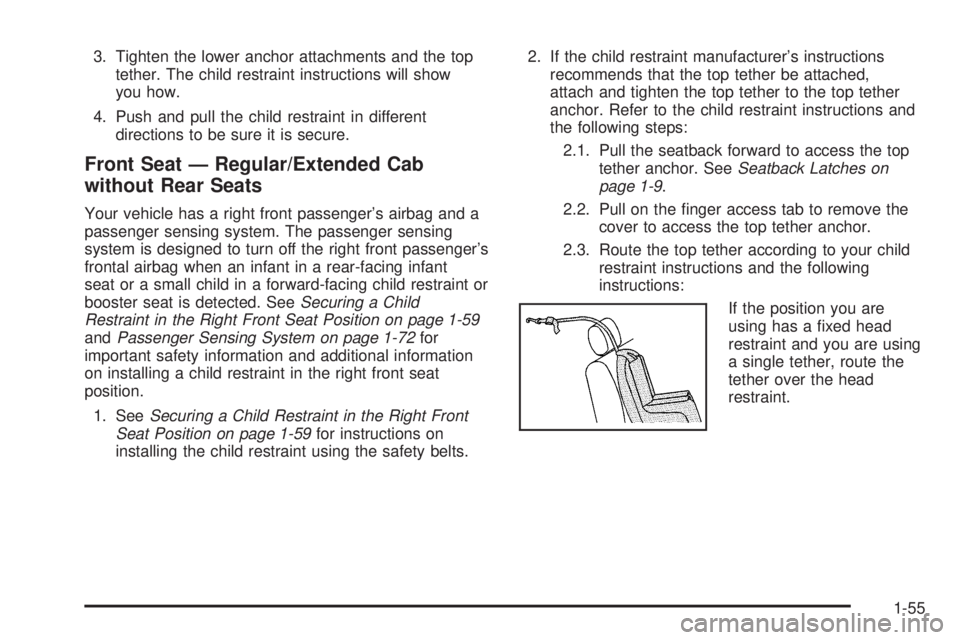
3. Tighten the lower anchor attachments and the top
tether. The child restraint instructions will show
you how.
4. Push and pull the child restraint in different
directions to be sure it is secure.
Front Seat — Regular/Extended Cab
without Rear Seats
Your vehicle has a right front passenger’s airbag and a
passenger sensing system. The passenger sensing
system is designed to turn off the right front passenger’s
frontal airbag when an infant in a rear-facing infant
seat or a small child in a forward-facing child restraint or
booster seat is detected. SeeSecuring a Child
Restraint in the Right Front Seat Position on page 1-59
andPassenger Sensing System on page 1-72for
important safety information and additional information
on installing a child restraint in the right front seat
position.
1. SeeSecuring a Child Restraint in the Right Front
Seat Position on page 1-59for instructions on
installing the child restraint using the safety belts.2. If the child restraint manufacturer’s instructions
recommends that the top tether be attached,
attach and tighten the top tether to the top tether
anchor. Refer to the child restraint instructions and
the following steps:
2.1. Pull the seatback forward to access the top
tether anchor. SeeSeatback Latches on
page 1-9.
2.2. Pull on the �nger access tab to remove the
cover to access the top tether anchor.
2.3. Route the top tether according to your child
restraint instructions and the following
instructions:
If the position you are
using has a �xed head
restraint and you are using
a single tether, route the
tether over the head
restraint.
1-55
Page 62 of 434

If the position you are using
has an adjustable head
restraint and you are using
a single tether, route the
tether under the head
restraint and in between
the head restraint posts.
If the position you are
using has a �xed or
adjustable head restraint
and you are using a
dual tether, route the tether
around the head restraint.
3. Attach and tighten the top tether according to your
child restraint instructions.
4. Push and pull the child restraint in different
directions to be sure it is secure.Securing a Child Restraint in a Rear
Seat Position
If your child restraint is equipped with the LATCH
system, seeLower Anchors and Tethers for Children
(LATCH) on page 1-46.
If your child restraint does not have the LATCH system,
you will be using the lap-shoulder belt to secure the
child restraint in this position. Be sure to follow the
instructions that came with the child restraint.
Secure the child in the child restraint when and as the
instructions say.
1. Put the child restraint on the seat.
2. Pick up the latch plate, and run the lap and shoulder
portions of the vehicle’s safety belt through or
around the restraint. The child restraint instructions
will show you how.
1-56
Page 63 of 434
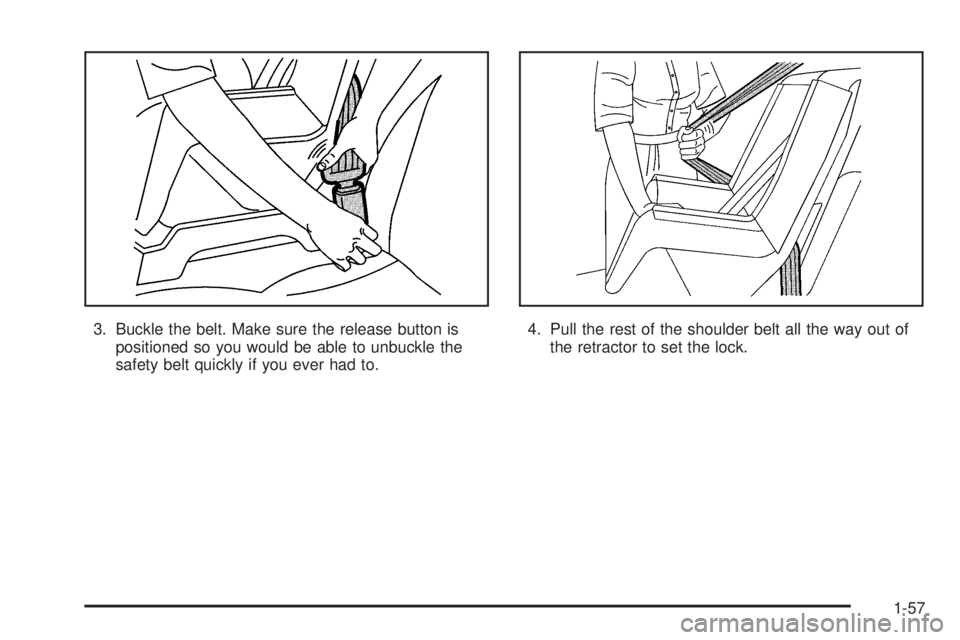
3. Buckle the belt. Make sure the release button is
positioned so you would be able to unbuckle the
safety belt quickly if you ever had to.4. Pull the rest of the shoulder belt all the way out of
the retractor to set the lock.
1-57
Page 64 of 434
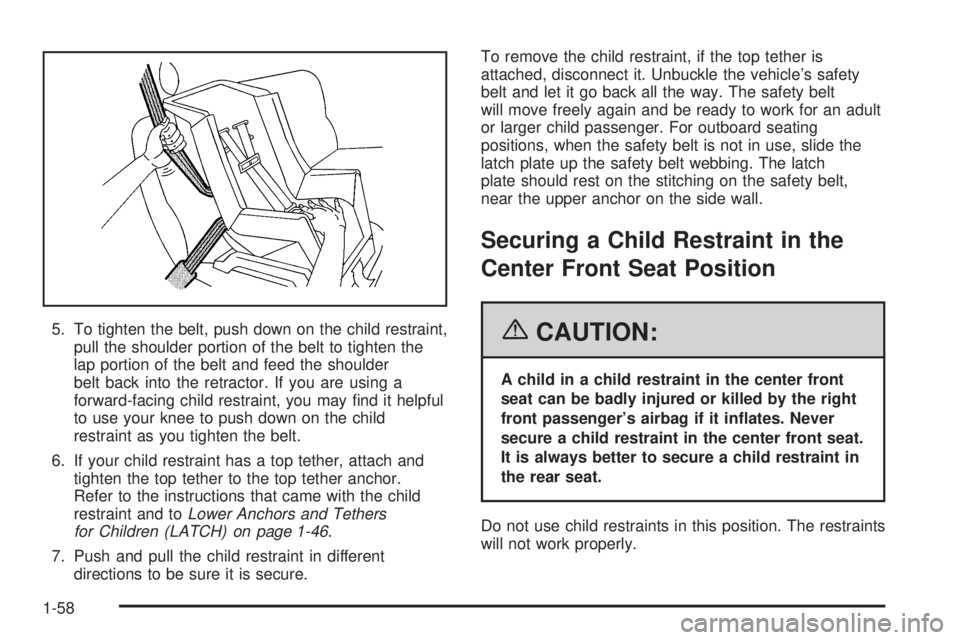
5. To tighten the belt, push down on the child restraint,
pull the shoulder portion of the belt to tighten the
lap portion of the belt and feed the shoulder
belt back into the retractor. If you are using a
forward-facing child restraint, you may �nd it helpful
to use your knee to push down on the child
restraint as you tighten the belt.
6. If your child restraint has a top tether, attach and
tighten the top tether to the top tether anchor.
Refer to the instructions that came with the child
restraint and toLower Anchors and Tethers
for Children (LATCH) on page 1-46.
7. Push and pull the child restraint in different
directions to be sure it is secure.To remove the child restraint, if the top tether is
attached, disconnect it. Unbuckle the vehicle’s safety
belt and let it go back all the way. The safety belt
will move freely again and be ready to work for an adult
or larger child passenger. For outboard seating
positions, when the safety belt is not in use, slide the
latch plate up the safety belt webbing. The latch
plate should rest on the stitching on the safety belt,
near the upper anchor on the side wall.
Securing a Child Restraint in the
Center Front Seat Position
{CAUTION:
A child in a child restraint in the center front
seat can be badly injured or killed by the right
front passenger’s airbag if it in�ates. Never
secure a child restraint in the center front seat.
It is always better to secure a child restraint in
the rear seat.
Do not use child restraints in this position. The restraints
will not work properly.
1-58
Page 65 of 434
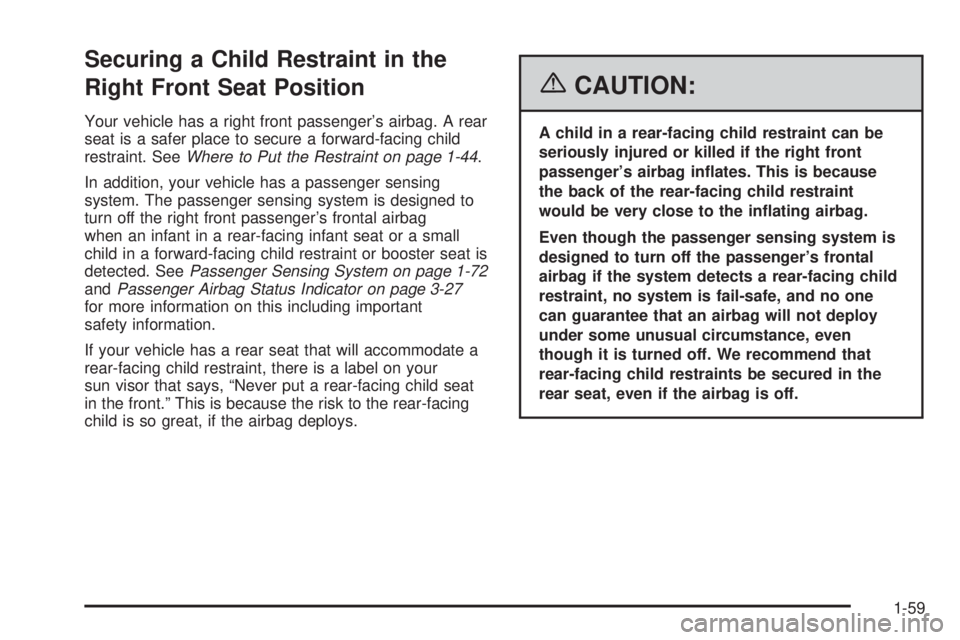
Securing a Child Restraint in the
Right Front Seat Position
Your vehicle has a right front passenger’s airbag. A rear
seat is a safer place to secure a forward-facing child
restraint. SeeWhere to Put the Restraint on page 1-44.
In addition, your vehicle has a passenger sensing
system. The passenger sensing system is designed to
turn off the right front passenger’s frontal airbag
when an infant in a rear-facing infant seat or a small
child in a forward-facing child restraint or booster seat is
detected. SeePassenger Sensing System on page 1-72
andPassenger Airbag Status Indicator on page 3-27
for more information on this including important
safety information.
If your vehicle has a rear seat that will accommodate a
rear-facing child restraint, there is a label on your
sun visor that says, “Never put a rear-facing child seat
in the front.” This is because the risk to the rear-facing
child is so great, if the airbag deploys.
{CAUTION:
A child in a rear-facing child restraint can be
seriously injured or killed if the right front
passenger’s airbag in�ates. This is because
the back of the rear-facing child restraint
would be very close to the in�ating airbag.
Even though the passenger sensing system is
designed to turn off the passenger’s frontal
airbag if the system detects a rear-facing child
restraint, no system is fail-safe, and no one
can guarantee that an airbag will not deploy
under some unusual circumstance, even
though it is turned off. We recommend that
rear-facing child restraints be secured in the
rear seat, even if the airbag is off.
1-59
Page 66 of 434
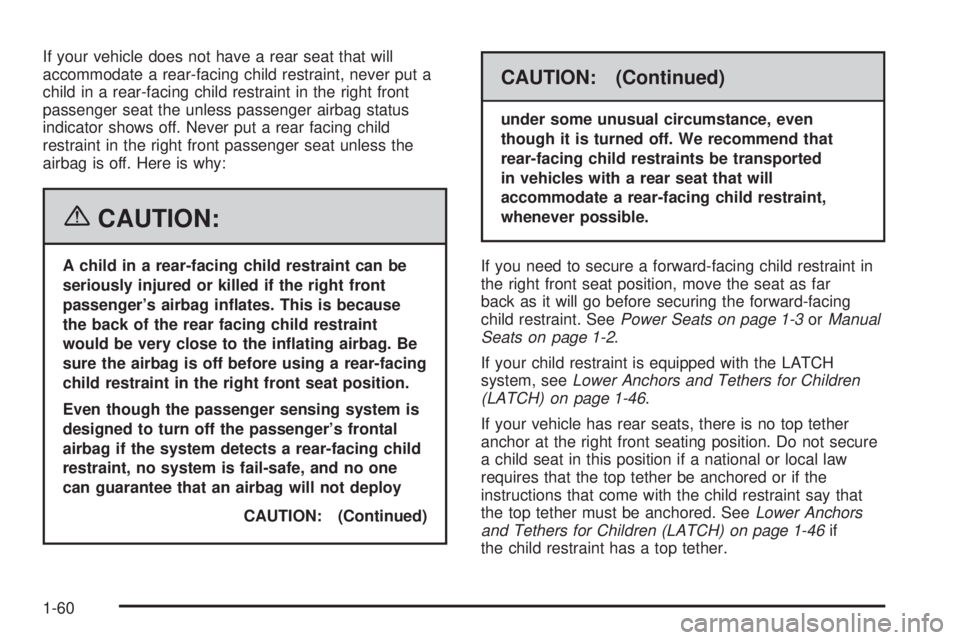
If your vehicle does not have a rear seat that will
accommodate a rear-facing child restraint, never put a
child in a rear-facing child restraint in the right front
passenger seat the unless passenger airbag status
indicator shows off. Never put a rear facing child
restraint in the right front passenger seat unless the
airbag is off. Here is why:
{CAUTION:
A child in a rear-facing child restraint can be
seriously injured or killed if the right front
passenger’s airbag in�ates. This is because
the back of the rear facing child restraint
would be very close to the in�ating airbag. Be
sure the airbag is off before using a rear-facing
child restraint in the right front seat position.
Even though the passenger sensing system is
designed to turn off the passenger’s frontal
airbag if the system detects a rear-facing child
restraint, no system is fail-safe, and no one
can guarantee that an airbag will not deploy
CAUTION: (Continued)
CAUTION: (Continued)
under some unusual circumstance, even
though it is turned off. We recommend that
rear-facing child restraints be transported
in vehicles with a rear seat that will
accommodate a rear-facing child restraint,
whenever possible.
If you need to secure a forward-facing child restraint in
the right front seat position, move the seat as far
back as it will go before securing the forward-facing
child restraint. SeePower Seats on page 1-3orManual
Seats on page 1-2.
If your child restraint is equipped with the LATCH
system, seeLower Anchors and Tethers for Children
(LATCH) on page 1-46.
If your vehicle has rear seats, there is no top tether
anchor at the right front seating position. Do not secure
a child seat in this position if a national or local law
requires that the top tether be anchored or if the
instructions that come with the child restraint say that
the top tether must be anchored. SeeLower Anchors
and Tethers for Children (LATCH) on page 1-46if
the child restraint has a top tether.
1-60
Page 67 of 434
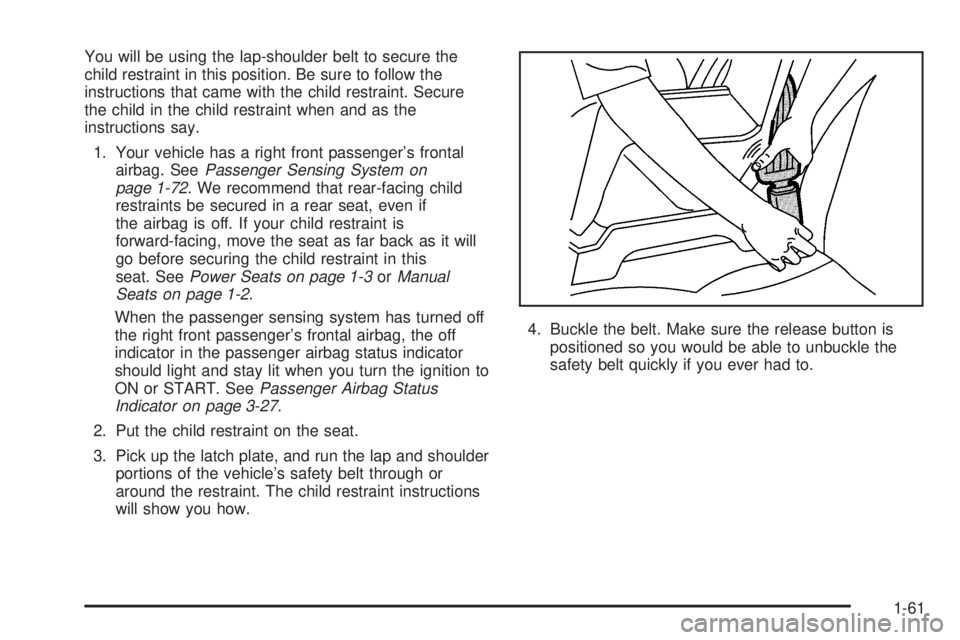
You will be using the lap-shoulder belt to secure the
child restraint in this position. Be sure to follow the
instructions that came with the child restraint. Secure
the child in the child restraint when and as the
instructions say.
1. Your vehicle has a right front passenger’s frontal
airbag. SeePassenger Sensing System on
page 1-72. We recommend that rear-facing child
restraints be secured in a rear seat, even if
the airbag is off. If your child restraint is
forward-facing, move the seat as far back as it will
go before securing the child restraint in this
seat. SeePower Seats on page 1-3orManual
Seats on page 1-2.
When the passenger sensing system has turned off
the right front passenger’s frontal airbag, the off
indicator in the passenger airbag status indicator
should light and stay lit when you turn the ignition to
ON or START. SeePassenger Airbag Status
Indicator on page 3-27.
2. Put the child restraint on the seat.
3. Pick up the latch plate, and run the lap and shoulder
portions of the vehicle’s safety belt through or
around the restraint. The child restraint instructions
will show you how.4. Buckle the belt. Make sure the release button is
positioned so you would be able to unbuckle the
safety belt quickly if you ever had to.
1-61
Page 68 of 434
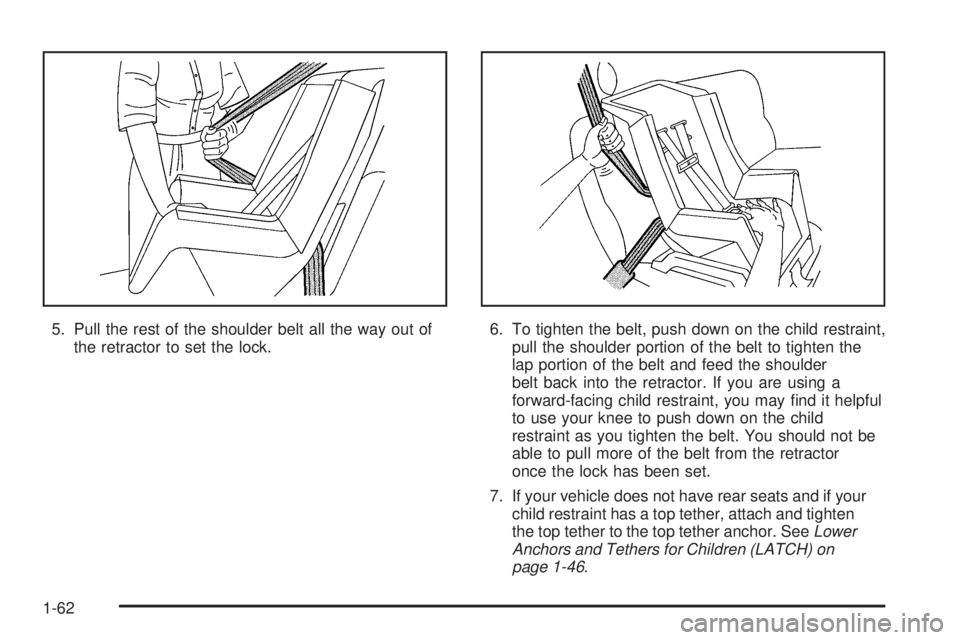
5. Pull the rest of the shoulder belt all the way out of
the retractor to set the lock.6. To tighten the belt, push down on the child restraint,
pull the shoulder portion of the belt to tighten the
lap portion of the belt and feed the shoulder
belt back into the retractor. If you are using a
forward-facing child restraint, you may �nd it helpful
to use your knee to push down on the child
restraint as you tighten the belt. You should not be
able to pull more of the belt from the retractor
once the lock has been set.
7. If your vehicle does not have rear seats and if your
child restraint has a top tether, attach and tighten
the top tether to the top tether anchor. SeeLower
Anchors and Tethers for Children (LATCH) on
page 1-46.
1-62
Page 69 of 434
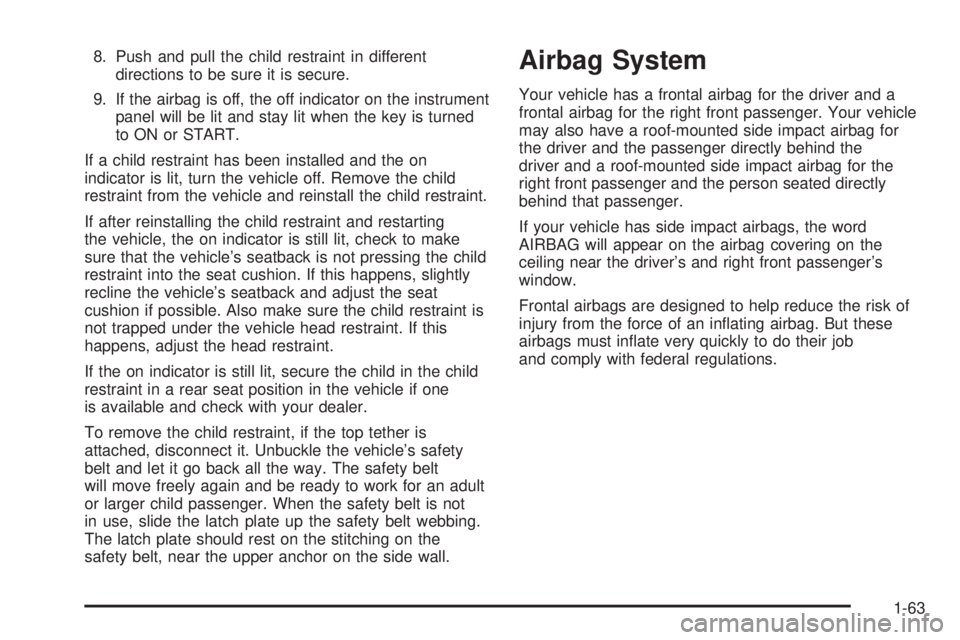
8. Push and pull the child restraint in different
directions to be sure it is secure.
9. If the airbag is off, the off indicator on the instrument
panel will be lit and stay lit when the key is turned
to ON or START.
If a child restraint has been installed and the on
indicator is lit, turn the vehicle off. Remove the child
restraint from the vehicle and reinstall the child restraint.
If after reinstalling the child restraint and restarting
the vehicle, the on indicator is still lit, check to make
sure that the vehicle’s seatback is not pressing the child
restraint into the seat cushion. If this happens, slightly
recline the vehicle’s seatback and adjust the seat
cushion if possible. Also make sure the child restraint is
not trapped under the vehicle head restraint. If this
happens, adjust the head restraint.
If the on indicator is still lit, secure the child in the child
restraint in a rear seat position in the vehicle if one
is available and check with your dealer.
To remove the child restraint, if the top tether is
attached, disconnect it. Unbuckle the vehicle’s safety
belt and let it go back all the way. The safety belt
will move freely again and be ready to work for an adult
or larger child passenger. When the safety belt is not
in use, slide the latch plate up the safety belt webbing.
The latch plate should rest on the stitching on the
safety belt, near the upper anchor on the side wall.Airbag System
Your vehicle has a frontal airbag for the driver and a
frontal airbag for the right front passenger. Your vehicle
may also have a roof-mounted side impact airbag for
the driver and the passenger directly behind the
driver and a roof-mounted side impact airbag for the
right front passenger and the person seated directly
behind that passenger.
If your vehicle has side impact airbags, the word
AIRBAG will appear on the airbag covering on the
ceiling near the driver’s and right front passenger’s
window.
Frontal airbags are designed to help reduce the risk of
injury from the force of an in�ating airbag. But these
airbags must in�ate very quickly to do their job
and comply with federal regulations.
1-63
Page 70 of 434
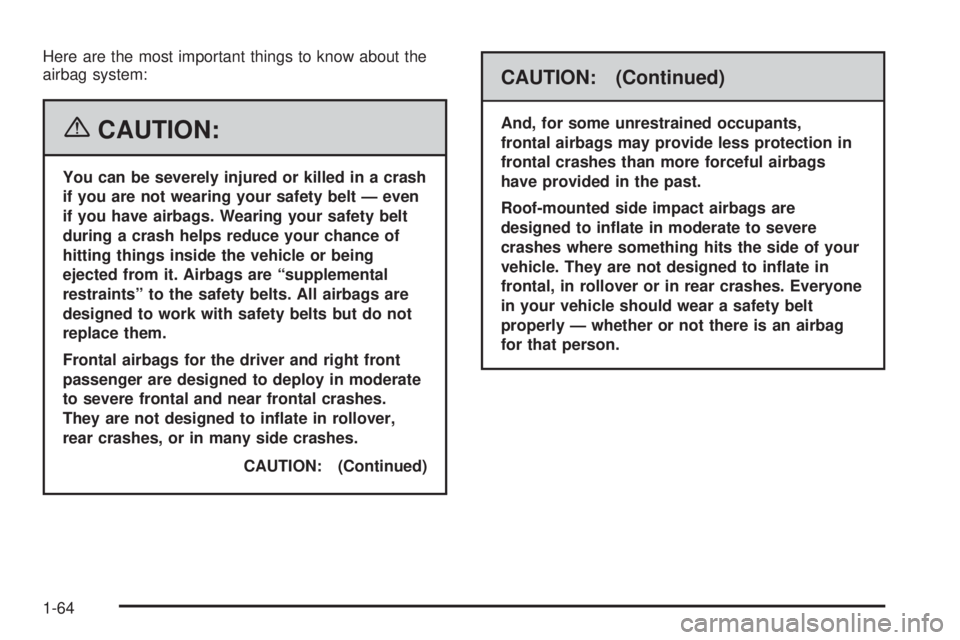
Here are the most important things to know about the
airbag system:
{CAUTION:
You can be severely injured or killed in a crash
if you are not wearing your safety belt — even
if you have airbags. Wearing your safety belt
during a crash helps reduce your chance of
hitting things inside the vehicle or being
ejected from it. Airbags are “supplemental
restraints” to the safety belts. All airbags are
designed to work with safety belts but do not
replace them.
Frontal airbags for the driver and right front
passenger are designed to deploy in moderate
to severe frontal and near frontal crashes.
They are not designed to in�ate in rollover,
rear crashes, or in many side crashes.
CAUTION: (Continued)
CAUTION: (Continued)
And, for some unrestrained occupants,
frontal airbags may provide less protection in
frontal crashes than more forceful airbags
have provided in the past.
Roof-mounted side impact airbags are
designed to in�ate in moderate to severe
crashes where something hits the side of your
vehicle. They are not designed to in�ate in
frontal, in rollover or in rear crashes. Everyone
in your vehicle should wear a safety belt
properly — whether or not there is an airbag
for that person.
1-64